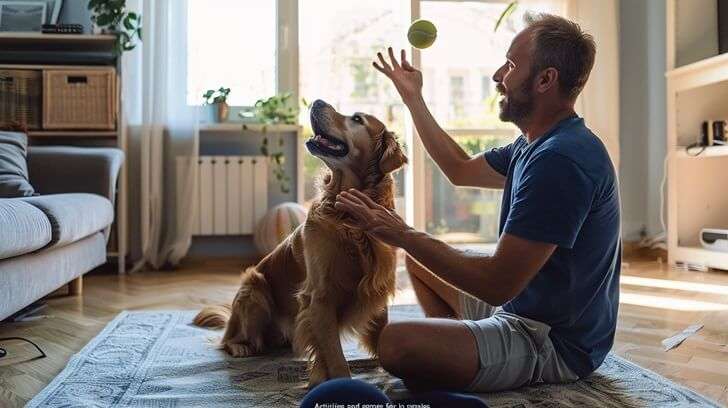
Living in a small apartment or a house with limited indoor space presents unique challenges for pet owners, especially when it comes to keeping your dog active and entertained. Dogs are energetic and intelligent animals that require daily physical and mental stimulation to stay healthy, but cramped spaces can make it difficult to give them the activity they need. This article is here to help you with just that, offering a variety of games for dogs that can be played indoors to keep them engaged and happy!
For many pet owners, not having access to a large backyard or nearby parks may feel limiting, but the good news is that there are plenty of ways to keep your dog busy and satisfied even in the tightest of spaces. Whether you’re living in an apartment, a small home, or have a dog who needs to spend more time indoors due to weather, there are plenty of options. From mental stimulation games to physical exercises that can be done in a small living room, this article will explore a variety of activities designed for dogs in small spaces.
We’ll take you through the key benefits of keeping your dog active indoors, practical ideas for indoor play, how to avoid common mistakes, and the best way to balance physical and mental exercise. These suggestions will not only help your dog stay happy and healthy but also strengthen the bond between you and your furry friend. So, if you’re ready to find creative ways to entertain your dog in a small space, keep reading—this guide will provide all the answers you need!
Benefits of Keeping Your Dog Active in Small Spaces
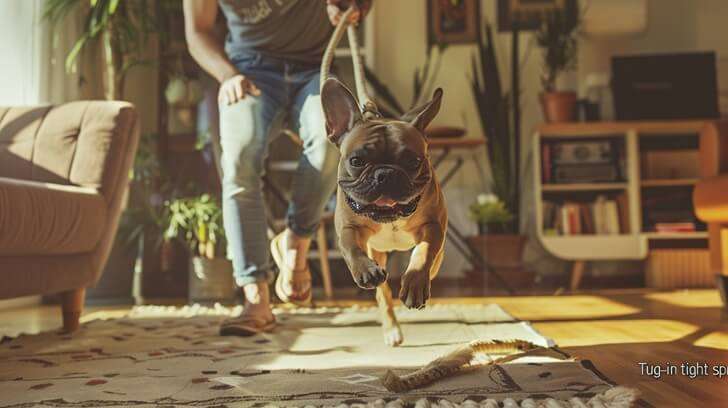
Dogs, no matter their breed or size, require consistent physical exercise and mental stimulation. Even if you live in a small apartment or a space with limited room, ensuring your dog stays active is crucial for their overall well-being. Below are five major benefits of keeping your dog active, even in small indoor spaces.
1. Maintaining Physical Health
Exercise is a cornerstone of good health for dogs. Lack of physical activity can lead to weight gain, muscle atrophy, joint issues, and even metabolic problems in pets. When dogs stay indoors for long periods without adequate exercise, they may become sluggish or put on unnecessary weight, increasing the risk of obesity-related illnesses such as diabetes or arthritis.
When you keep your dog physically active, even through indoor games like fetch or agility exercises, it ensures they maintain a healthy weight, strong muscles, and a healthy heart. Regular indoor activities can also improve circulation and maintain healthy joints, which is especially important for older dogs who may not be able to run long distances.
2. Mental Stimulation
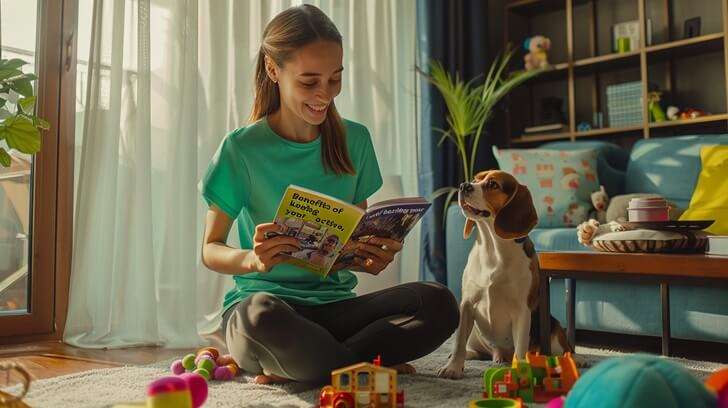
While physical exercise is essential, mental stimulation is just as crucial for a dog’s happiness. Dogs are intelligent creatures and require mental challenges to keep them engaged and entertained. Without enough mental stimulation, dogs can become bored, leading to destructive behaviors like chewing on furniture, excessive barking, or digging.
Mentally stimulating games such as puzzle toys, interactive challenges, or teaching new tricks can help keep your dog’s brain sharp. These activities encourage your dog to problem-solve and keep their cognitive functions working effectively. Dogs that receive enough mental stimulation are often happier, more balanced, and less prone to behavior issues.
3. Preventing Behavioral Problems
Dogs that don’t receive enough physical and mental stimulation often exhibit unwanted behaviors. If you find that your dog is digging, chewing, barking excessively, or showing signs of anxiety, these behaviors could be a result of boredom. Dogs need an outlet for their energy, and without the opportunity to exercise or play, they may resort to these destructive behaviors to relieve frustration.
By incorporating regular indoor games and activities, you give your dog a way to expend their energy in a healthy, controlled manner. This, in turn, reduces the likelihood of bad behavior, helping your dog stay well-adjusted and calm.
4. Strengthening the Bond Between You and Your Dog
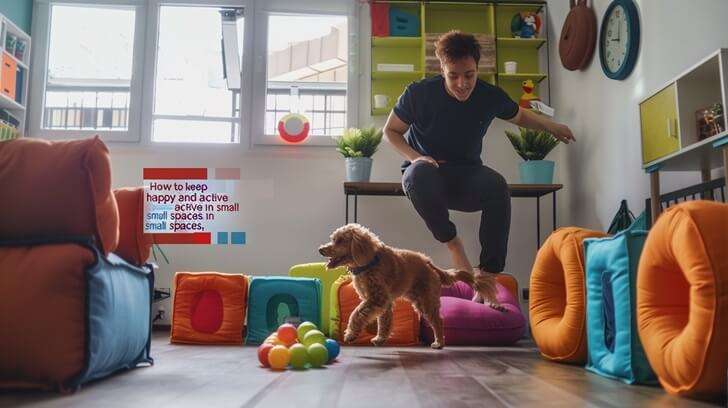
Interactive play is one of the most effective ways to strengthen the bond between you and your dog. When you actively engage in games or training with your dog, it fosters communication and mutual trust. Your dog will learn to depend on you for guidance, affection, and fun, reinforcing positive behaviors and making them more responsive to your commands.
Games like tug-of-war, fetch, or training sessions create positive associations with you, which can lead to better obedience and overall behavior. The more time you spend interacting with your dog, the stronger your bond becomes.
5. Indoor Play is Ideal for All Breeds and Sizes
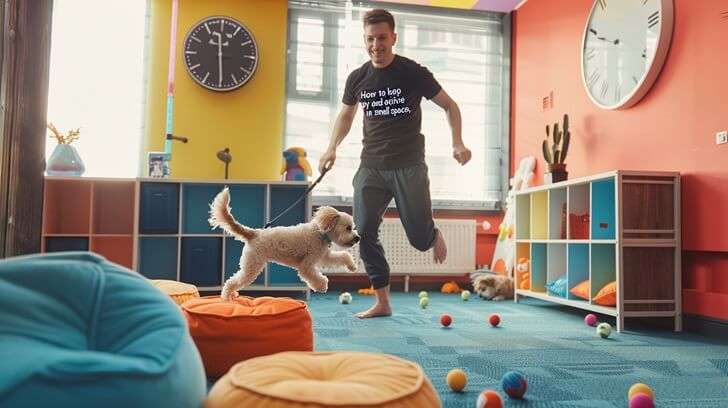
The great thing about playing indoors is that it’s suitable for any dog, no matter their size or breed. While larger breeds like German Shepherds or Golden Retrievers may require more intense exercise, smaller breeds like Pugs or Dachshunds may need less. Indoor activities can be customized based on your dog’s energy level and size. The key is to find activities that match your dog’s needs, ensuring they are both mentally and physically fulfilled without overexertion.
By keeping these benefits in mind, it becomes clear that maintaining an active routine for your dog—whether indoors or outdoors—is essential for their health and happiness.
How to Design Activities for Dogs in Small Spaces
When it comes to designing indoor activities for your dog, planning and creativity are your best tools. The key to successfully keeping your dog active in small spaces is to make the most of the available space and ensure the activities are safe, fun, and engaging. Here’s how to do it:
1. Evaluate Your Space
The first step in creating activities for your dog indoors is to assess the space you have. This could be a living room, hallway, or even the kitchen. Make sure the area is clear of any fragile or sharp objects, and be aware of any obstacles that might pose a tripping hazard for both you and your dog.
Use multifunctional furniture to create activity zones. For example, a coffee table can serve as a tunnel for your dog to crawl under, or a hallway can become a space for fetch. Take advantage of any clear areas by rearranging furniture if necessary to give your dog enough room to play.
2. Set Up Designated Play Zones
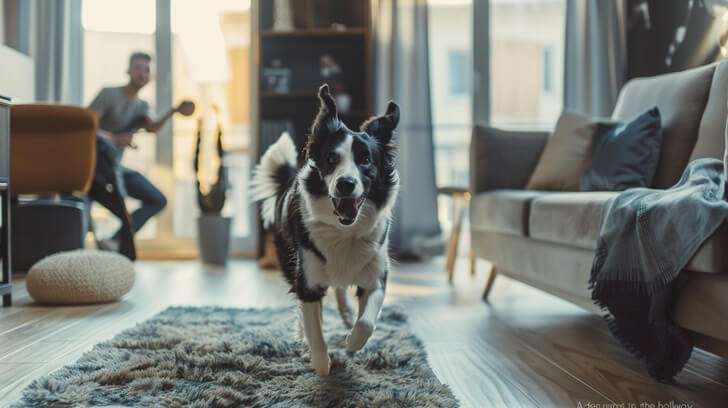
If you live in an apartment or a house with limited space, designate specific areas for your dog’s activities. These could be a corner of the living room, a small nook, or an open area in the kitchen. By having designated spaces, your dog will start associating those areas with playtime, which can make it easier for them to settle down when they’re in other parts of the home.
You can also create indoor boundaries with baby gates to keep your dog within a specific area. This prevents your dog from running into unsafe parts of your home, like the kitchen or bathroom, while giving them freedom to move around in their designated play space.
3. Invest in Indoor-Friendly Toys
To get the most out of indoor activities, consider investing in toys that are specifically designed for indoor play. Soft balls, lightweight frisbees, and interactive puzzle toys are great options that won’t damage furniture or break fragile items. Puzzle toys and treat-dispensing toys are especially useful, as they keep your dog engaged for long periods of time while also providing mental stimulation.
Interactive toys that encourage independent play can be helpful if you’re working from home or need to occupy your dog while you’re busy. These toys allow your dog to stay entertained without requiring constant attention from you.
4. Create Safety Precautions
Even indoors, safety should always be a priority. Before starting any physical activities with your dog, make sure the space is free of sharp objects, toxic plants, or any items that your dog could accidentally knock over. Dogs may get overexcited during play and become a little clumsy, so having a clear, safe area is essential.
If your dog tends to chew on furniture or objects, keep an eye out for potential hazards, such as electrical cords or small items that can be swallowed. Always supervise your dog during playtime to ensure their safety.
Physical Activities for Dogs in Small Spaces

Many dog owners believe that physical activities for dogs are only effective outdoors in wide-open spaces, but the truth is that dogs can get plenty of exercise indoors as well. Here are several engaging activities that will keep your dog moving, even when you’re limited by space.
1. Indoor Fetch
One of the simplest yet most effective ways to exercise your dog indoors is by playing fetch. While fetch is usually associated with outdoor play, it can be adapted for small spaces using soft toys or balls. Make sure you’re using lightweight, soft toys to avoid damaging furniture or walls, and ensure the area is clear of any fragile objects.
Toss the toy short distances for your dog to retrieve, or use a hallway to add more length to the game. This activity provides your dog with physical exercise while also reinforcing the “drop” command, which can be helpful for training purposes.
2. Tug-of-War
Tug-of-war is a great way to burn off your dog’s excess energy indoors. Use a sturdy rope toy and engage in a gentle game of tug. Be sure to encourage breaks during the game and teach your dog the “release” or “drop it” command to ensure they understand when to stop. Tug-of-war can help your dog burn calories and strengthen their muscles, while also giving you an opportunity to bond with them.
This game is ideal for dogs that love interactive play and can be done in even the smallest living rooms.
3. Create an Agility Course with Household Items
You don’t need to purchase expensive agility equipment to create a fun course for your dog. Household items like chairs, stools, and broomsticks can be used to create jumps or obstacles for your dog to navigate. For example, set up a couple of chairs with a broomstick between them to create a jump, or use pillows and cushions as obstacles to climb over.
Agility courses provide both mental and physical stimulation for your dog and help improve their coordination. Adjust the height of the obstacles based on your dog’s size and abilities to ensure they are comfortable and safe.
4. Staircase Fetch or Climb
If your home has stairs, take advantage of them for a more intense physical workout. Stair exercises are excellent for dogs, as they require more effort than running on flat surfaces. You can play fetch by tossing a soft toy or ball up or down the stairs, encouraging your dog to run after it. Alternatively, guide your dog up and down the stairs on a leash for a controlled and steady exercise.
However, be cautious when using stairs with older dogs or dogs with joint issues, as this activity may be too strenuous for them. Always monitor your dog closely to ensure they’re not overexerting themselves.
5. Hide-and-Seek
Hide-and-seek is a fantastic game that combines both physical and mental stimulation. Start by having your dog stay in one place (you can use the “stay” command) while you hide somewhere in the house. Once you’re hidden, call your dog and have them find you. This game challenges your dog’s problem-solving skills and engages their natural hunting instincts.
As your dog becomes more familiar with the game, try hiding in more difficult spots to increase the level of challenge. This game can be a fun bonding experience and is perfect for dogs that enjoy using their nose to track down their owner.
6. Chase Bubbles
Many dogs love chasing bubbles, and this is an excellent way to give your dog some light exercise indoors. You can purchase pet-safe bubble solutions specifically designed for dogs and blow bubbles around your living room for your dog to chase. The activity stimulates your dog’s sense of sight and encourages them to jump and run around, all while being gentle on their joints.
Bubble play is a low-impact game, making it ideal for older dogs or dogs with limited mobility.
Mental Stimulation Games for Dogs in Small Spaces
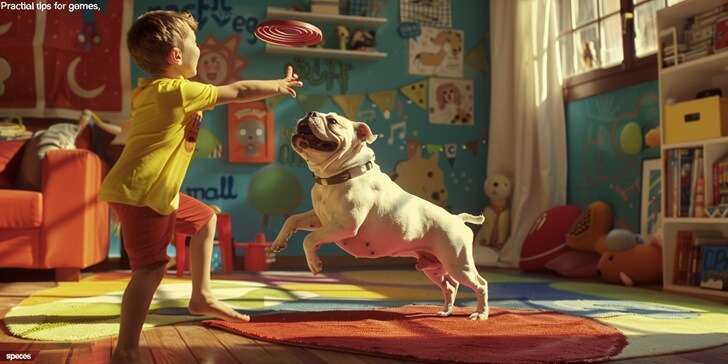
Physical exercise alone isn’t enough to keep your dog happy; mental stimulation is equally important. Dogs need to engage their minds to stay entertained and prevent boredom. Here are some indoor games that will keep your dog mentally sharp while living in a small space.
1. Puzzle Toys
Puzzle toys are a great way to challenge your dog mentally. These toys require your dog to figure out how to access treats or rewards hidden inside. They come in various difficulty levels, so you can choose a puzzle that matches your dog’s intelligence and experience.
You can find puzzle toys that involve sliding, spinning, or flipping components to reveal treats, keeping your dog engaged and thinking. These toys are perfect for dogs that love problem-solving and can keep them occupied for long periods.
2. Interactive Toys
Interactive toys like treat-dispensing balls or automatic fetch machines are excellent for indoor play. These toys encourage independent play and allow your dog to engage with the toy without constant input from you. For example, treat-dispensing toys will release a treat every time your dog rolls or paws at them, rewarding their efforts and encouraging continued play.
Interactive toys stimulate both your dog’s body and mind, helping to relieve boredom when you’re busy.
3. Teach New Tricks
Learning new tricks is a fantastic way to mentally stimulate your dog. Use positive reinforcement techniques to teach your dog new commands such as “spin,” “roll over,” or “high five.” Training sessions should be short and fun, with plenty of rewards for success.
The process of learning a new trick requires your dog to focus and think, providing an excellent mental workout. Plus, teaching new tricks strengthens the bond between you and your dog, as it relies on communication and trust.
4. Nose Work and Scent Games
Dogs have an incredible sense of smell, and nose work is an excellent way to tap into their natural instincts. Hide treats or toys around the house and encourage your dog to find them using their nose. Start by placing treats in easy-to-find spots and gradually increase the difficulty by hiding them in more challenging locations.
This game stimulates your dog’s sense of smell and keeps their mind engaged. It’s also a low-impact activity, making it suitable for dogs of all ages and sizes.
5. Name That Toy
This game involves teaching your dog the names of their toys and having them retrieve the correct one when asked. Start by selecting two or three of your dog’s favorite toys and assigning each one a name. Use the toy’s name repeatedly during play, and eventually, your dog will start to associate the name with the specific toy.
Once your dog has learned the names of their toys, you can ask them to retrieve a specific one, challenging their memory and comprehension. This game provides mental stimulation and can be a fun way to incorporate training into playtime.
Balancing Physical and Mental Exercise for Your Dog

A well-rounded routine for your dog includes a healthy balance of both physical and mental exercise. Focusing too much on one over the other can leave your dog either physically tired but mentally restless, or mentally satisfied but still full of energy. Here’s how you can ensure your dog gets the right balance of both types of stimulation.
1. Plan a Daily Routine
Dogs thrive on routine, so try to establish a consistent schedule for both physical and mental activities. Start the day with a short indoor walk or play session to burn off some energy, followed by a mentally stimulating game like a puzzle toy.
Break up the day with short, frequent activity breaks that incorporate a mix of physical and mental exercises. For example, you can play fetch for 10 minutes in the morning and follow it up with a training session or puzzle game in the afternoon. By alternating between physical and mental activities, you keep your dog engaged without overexerting them.
2. Tailor Activities to Your Dog’s Needs
Every dog is different, and their exercise needs will vary based on their breed, age, and individual temperament. Younger dogs or high-energy breeds may require more physical activity, while older dogs or those with health issues may benefit from more low-impact exercises and mental games.
Pay attention to your dog’s cues—if they seem restless or bored after a mentally stimulating game, they may need more physical activity. Conversely, if they appear physically tired but still alert, they may benefit from a mentally stimulating puzzle or training session.
3. Incorporate Training into Play
Training doesn’t have to be separate from playtime. Incorporating obedience training into your dog’s daily activities is a great way to provide both physical and mental stimulation. For example, you can practice commands like “sit,” “stay,” or “come” during games of fetch or tug-of-war.
Training requires focus and discipline, engaging your dog’s mind while also reinforcing positive behavior. Plus, it helps to create structure and routine, which many dogs find comforting.
4. Monitor Your Dog’s Energy Levels
Just like humans, dogs have good days and bad days. There will be times when your dog is full of energy and ready for a game of tug-of-war or fetch, and other days when they may prefer a more relaxed puzzle toy or cuddle time.
Monitor your dog’s energy levels and adjust their activities accordingly. Don’t push your dog to exercise when they seem tired or disinterested—sometimes a quiet day with more mental stimulation is exactly what they need.
Conclusion and Final Thoughts
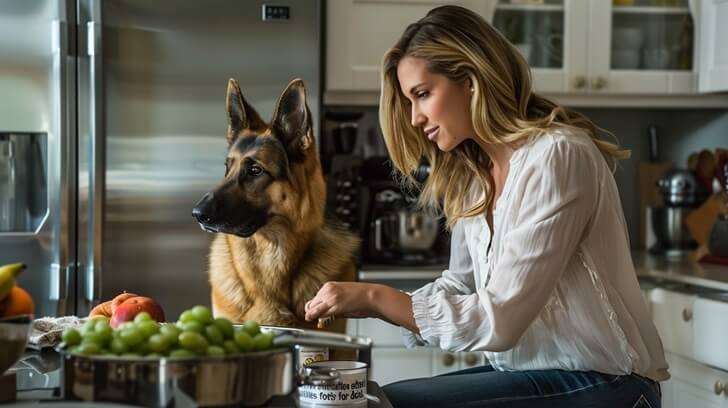
Keeping your dog active in a small space may seem challenging at first, but with a little creativity and planning, you can ensure your dog stays happy, healthy, and engaged indoors. Whether it’s a game of indoor fetch, a mentally stimulating puzzle, or a fun agility course, there are plenty of ways to provide your dog with the exercise they need without leaving the house.
The key to success is finding the right balance between physical and mental activities, while tailoring your approach to fit your dog’s individual needs and the space you have available. Remember that dogs thrive on routine and consistency, so try to establish a daily schedule that includes both types of exercise.
Don’t forget that indoor activities are also an excellent opportunity to strengthen the bond between you and your dog. By actively engaging with your dog through play and training, you build trust, improve communication, and enhance their overall well-being.
Even if you’re limited by space, your dog can still lead a fulfilling and active life indoors. With the right approach, small space living doesn’t have to be a barrier to your dog’s happiness—it can be a gateway to creative and fun new ways to spend time together.
And if you’re interested in diving deeper into training techniques and activities that will keep your dog engaged, consider checking out the Dog Trainer Bible —an invaluable resource for pet owners looking to make the most out of their time with their dogs. Happy playing!
